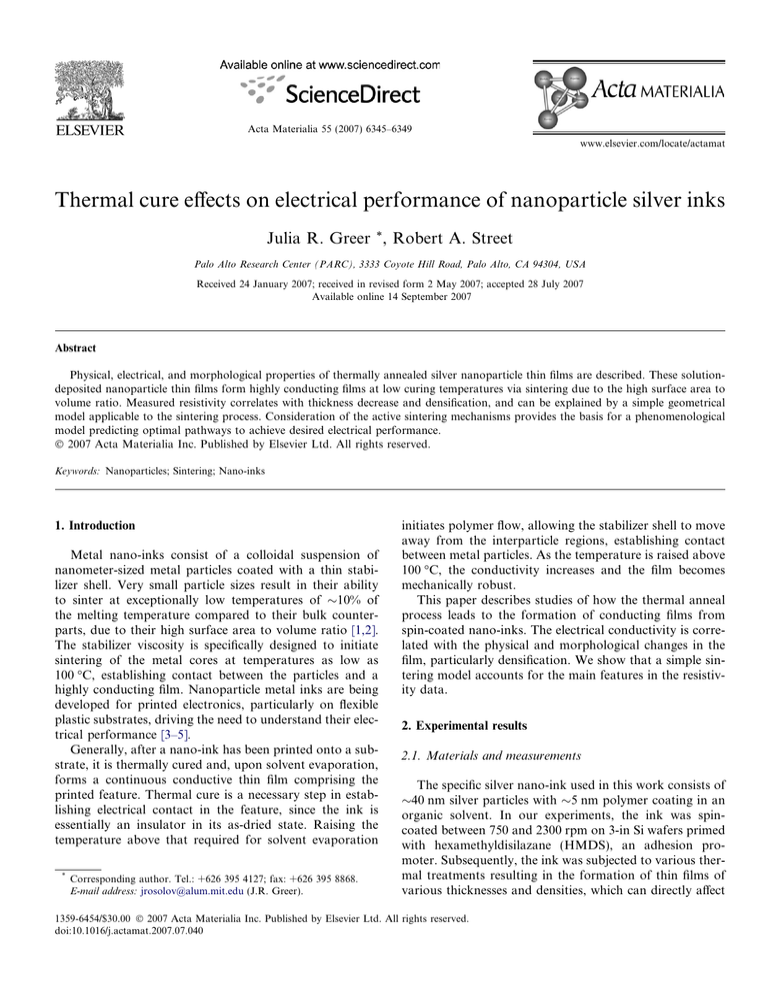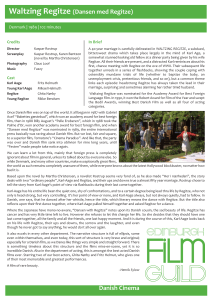
Acta Materialia 55 (2007) 6345–6349
www.elsevier.com/locate/actamat
Thermal cure effects on electrical performance of nanoparticle silver inks
Julia R. Greer *, Robert A. Street
Palo Alto Research Center (PARC), 3333 Coyote Hill Road, Palo Alto, CA 94304, USA
Received 24 January 2007; received in revised form 2 May 2007; accepted 28 July 2007
Available online 14 September 2007
Abstract
Physical, electrical, and morphological properties of thermally annealed silver nanoparticle thin films are described. These solutiondeposited nanoparticle thin films form highly conducting films at low curing temperatures via sintering due to the high surface area to
volume ratio. Measured resistivity correlates with thickness decrease and densification, and can be explained by a simple geometrical
model applicable to the sintering process. Consideration of the active sintering mechanisms provides the basis for a phenomenological
model predicting optimal pathways to achieve desired electrical performance.
2007 Acta Materialia Inc. Published by Elsevier Ltd. All rights reserved.
Keywords: Nanoparticles; Sintering; Nano-inks
1. Introduction
Metal nano-inks consist of a colloidal suspension of
nanometer-sized metal particles coated with a thin stabilizer shell. Very small particle sizes result in their ability
to sinter at exceptionally low temperatures of 10% of
the melting temperature compared to their bulk counterparts, due to their high surface area to volume ratio [1,2].
The stabilizer viscosity is specifically designed to initiate
sintering of the metal cores at temperatures as low as
100 C, establishing contact between the particles and a
highly conducting film. Nanoparticle metal inks are being
developed for printed electronics, particularly on flexible
plastic substrates, driving the need to understand their electrical performance [3–5].
Generally, after a nano-ink has been printed onto a substrate, it is thermally cured and, upon solvent evaporation,
forms a continuous conductive thin film comprising the
printed feature. Thermal cure is a necessary step in establishing electrical contact in the feature, since the ink is
essentially an insulator in its as-dried state. Raising the
temperature above that required for solvent evaporation
*
Corresponding author. Tel.: +626 395 4127; fax: +626 395 8868.
E-mail address: jrosolov@alum.mit.edu (J.R. Greer).
initiates polymer flow, allowing the stabilizer shell to move
away from the interparticle regions, establishing contact
between metal particles. As the temperature is raised above
100 C, the conductivity increases and the film becomes
mechanically robust.
This paper describes studies of how the thermal anneal
process leads to the formation of conducting films from
spin-coated nano-inks. The electrical conductivity is correlated with the physical and morphological changes in the
film, particularly densification. We show that a simple sintering model accounts for the main features in the resistivity data.
2. Experimental results
2.1. Materials and measurements
The specific silver nano-ink used in this work consists of
40 nm silver particles with 5 nm polymer coating in an
organic solvent. In our experiments, the ink was spincoated between 750 and 2300 rpm on 3-in Si wafers primed
with hexamethyldisilazane (HMDS), an adhesion promoter. Subsequently, the ink was subjected to various thermal treatments resulting in the formation of thin films of
various thicknesses and densities, which can directly affect
1359-6454/$30.00 2007 Acta Materialia Inc. Published by Elsevier Ltd. All rights reserved.
doi:10.1016/j.actamat.2007.07.040
6346
J.R. Greer, R.A. Street / Acta Materialia 55 (2007) 6345–6349
their electrical performance. The final film thickness was
found to be inversely proportional to the ink spin speed,
and after drying was on the order of 500 nm for spin
speeds between 800 rpm and 2000 rpm.
The sheet resistance of the formed metal films was measured using the 4-point probe method. A geometric correction factor (CF) is usually required to convert the voltage/
current ratio measured by the 4-point probe into sheet
resistance. This correction factor accounts for the sample
size, shape and probe spacing. The sheet resistance measured by the probe is given by
Rsheet ¼ V =I CF;
ð1Þ
where V is the measured DC voltage across the two voltage
probes and I is the DC current passing through the two
current probes. The CF value of 3.1 for samples of various
sizes and shapes was found in the instrument manual. The
film thickness was monitored by a Dektak step profilometer. Electrical resistivity was then calculated as the product
of the measured film thickness tf and the measured sheet
resistance.
2.2. Physical changes during annealing
To estimate the degree of densification, the weight and
thickness of representative films were monitored throughout the heating process, starting at room temperature in
the liquid ink phase until its final solid state. The ink thickness prior to solvent evaporation was monitored by a laser
interferometer at increments of 10 C. The evolution of film
thickness, total film weight, and silver weight fraction normalized by their initial values are shown as a function of
temperature, as the ink is heated from room temperature
to 300 C, in Fig. 1. The sample was first heated at a constant rate of 2 C min1 up to 120 C, followed by an isothermal hold for 1 h, another heating segment up to
150 oC, isothermal hold for 20 min, and final heating segment up to 300 C.
The nearly 80% initial weight loss upon heating up to
100 C is due to the solvent evaporation and then the
weight remains nearly constant as the film densifies at
higher temperatures. The final mass of the film agrees with
the reported initial Ag weight fraction of 0.2 in the colloidal suspension. It is clear from Fig. 1 that the film thickness
Fig. 1. Evolution of film thickness, weight, and silver weight fraction
normalized by their initial values as a function of temperature. The initial
weight loss is due to the solvent evaporation while it remains nearly
constant as the film densifies. The final mass of the film agrees with the
reported initial Ag weight fraction of 0.2 in the colloidal suspension. Film
thickness decrease is more pronounced at higher temperatures.
decrease becomes more pronounced at higher temperatures. Upon further heating above 100 C, the mass
remained unchanged within the experimental error, while
the film thickness was reduced to 75% of its value at
100 C. The thickness reduction is small between 100 and
120 C, but becomes more substantial at higher temperatures as well as during the isothermal holds, with a decrease
of 3% at 120 C and 8% at 150 C. These observations
show that at higher temperatures densification occurs,
since density, a ratio of mass and volume, increases as
the film becomes thinner. This is also consistent with sintering of the film.
The evolution of the porosity and microstructure of the
film is illustrated by the SEM images in Fig. 2, showing the
film microstructure as it evolved from the as-dried state to
a slightly sintered state when cured for 5 min at 150 C, followed by a fully annealed phase after a 3 h cure at the same
temperature.
2.3. Resistivity changes
The sintering and densification processes directly affect
the electrical properties of these films. Resistivities during
isothermal anneals are shown by data points in Fig. 3.
Fig. 2. SEM images of 100 nm silver nanoparticle film in as-dried condition (top view), followed by curing at 150 C for 5 min (25 tilt), and for 3 h
resulting in a continuous porous film.
J.R. Greer, R.A. Street / Acta Materialia 55 (2007) 6345–6349
Fig. 3. Resistivity as a function of cure time during isothermal holds at
various temperatures as compared with the bulk resistivity of silver.
The continuous curves in the figure represent models which
are discussed in a subsequent section. The data show that
even after 3 h holds, the resistivities of films cured under
150 C did not reach the bulk resistivity of silver of
1.6 · 108 X m, shown for comparison by a long-dashed
line. Isothermal holds performed at higher temperatures
(150 C and above) are conducive to much more rapid
reduction in resistivity and achieve close-to-bulk values
after only a short hold time. For example, curing the film
for 15 min at 150 C results in a 50% resistivity drop,
while at 120 C it is only 20%. The final resistivity varies
from 20 · 108 X m at 120 C to <5 · 108 X m, achieved
at 180 C and above.
Fig. 4 shows linear shrinkage, sheet resistance, and resistivity evolution of a representative nano-ink film during
isothermal cure at 150 C and demonstrates that the overall
resistance reduction is due mainly to the nearly instantaneous sheet resistance drop rather than to linear shrinkage.
The rapid decline in sheet resistance suggests that at some
Fig. 4. The overall resistance reduction during a typical 150 C cure is due
mainly to the nearly instantaneous sheet resistance drop rather than to
linear shrinkage.
6347
Fig. 5. Resistivity as a function of cure time during constant heating rate.
instant the particles form a well-connected, continuous,
and conductive network. Unlike during isothermal holds,
when cure is conducted at a constant heating rate the largest drop in resistivity occurs at temperatures below
130 C, as shown in Fig. 5. It is also apparent that the
absolute resistivity is higher at a given temperature compared with the film that was first cured at a lower temperature isothermally. For example, when continuously
heated, the resistivity of 11.7 · 108 X m at 180 C is
higher than that for isothermal cure at a lower
temperature.
3. Discussion
These changes in film thickness and sheet resistance
arise from sintering, a material transport process based
on the atomic diffusion driven by the reduction of interfacial energy. A schematic of possible diffusion paths
during sintering between two particles is shown in
Fig. 6. Paths 1 and 2 correspond to surface and lattice
Fig. 6. A schematic representing various atomic diffusion paths between
two contacting particles. Paths 1 and 2 do not produce any shrinkage
while Paths 3 and 4 enable the sphere centers to approach one another,
resulting in densification.
6348
J.R. Greer, R.A. Street / Acta Materialia 55 (2007) 6345–6349
diffusion, respectively; these mechanisms do not cause
densification since no change in distance between the
sphere centers occurs. In crystalline materials, shrinkage,
and therefore densification, can occur only when the
atoms are removed from the contact surface, or a grain
boundary, so that the centers of the spheres can move
towards one another (Paths 3 and 4). In these processes,
the centers of spherical particles approach one another,
as the neck between them widens, increasing the particle
contact area [6]. The neck formation is also driven by the
reduction in surface energy by atomic diffusion, where
the material fluxes from the areas of convex, or positive,
curvature to the regions of negative, or concave, curvature [7–9]. The energy reduction by neck formation is offset by the energy of grain boundary creation, and this
energy balance dictates the final shape of the pore. These
atomic diffusion processes compete with each other: for
example, surface diffusion generally prevails in the initial
sintering stages, as it has the easiest transport path as
well as a low activation energy. While the atomic mobility within a grain boundary is much higher than that in
the lattice, it cannot accommodate a large number of
atoms, so the atomic flux in the very thin grain boundary is much lower compared with that in the lattice
[10–13]. The activation energy for grain boundary diffusion is much lower than that for lattice diffusion, making
the former prevail in the initial stages of sintering, when
densification is minimal, and the latter at high temperatures, when most shrinkage occurs. One of the key factors in determining the dominant transport mechanisms
is the initial particle, or grain, size: the smaller the grain,
the larger the volume fraction occupied by the grain
boundary [14,15]. The kinetics of sintering are complex,
as they depend on which of these transport mechanisms
is (are) dominant.
3.1. Sintering model relating densification and resistivity
strate a simple relation between the engineering strain e,
linear dimension L, and the fractional neck radius z/a, as
a function of time:
rffiffiffiffiffiffiffiffiffiffiffiffiffiffiffiffiffiffi
z 2ffi
LðtÞ ¼ Lð0Þ 1 ð2Þ
a
where L(0) = 2a is the initial distance between the sphere
centers. The linear shrinkage can be related to the resistivity using simplifying assumptions to describe the coalescence of two spheres: (1) the linear contraction of the
film in vertical dimension is equal to the decrease in the distance between the sphere centers and (2) the atomic diffusion path maintains Fig. 8 shape as the spheres approach
each other. There is a further assumption that the densification is isotropic. Our experiments measure the vertical
densification and we apply these results to the in-plane sintering of the film.
This model assumptions result in the following relationship between resistance and resistivity:
Z a
Z a
dx
1
dx
R ¼ q0
¼ q0 2
;
ð3Þ
a a pðz=aÞ2
a A
where q0 is the initial resistivity of the material, x is the distance along the centerline of the two spheres, and A is the
contact area between the spheres. Assuming that the final
or ‘‘fully sintered’’ state can be geometrically represented
by a cube of side 2a, the resistivity can be expressed in
terms of the linear distance L and sphere radius a by integrating Eq. (2) and solving Eq. (1):
2q0
a þ LðtÞ=2
qðtÞ ¼
ln
:
ð4Þ
a LðtÞ=2
p
The plot in Fig. 8 shows this resistivity plotted as a function of remaining fractional film thickness, L(t)/L(0), for
an isothermal anneal at 150 C and compared to data
from Fig. 4. The fit is obtained with q0 = 3 · 108 X m,
which is approximately twice as large as the bulk resistiv-
In order to relate resistivity to densification, we base our
analysis on the geometry introduced by the classic TwoSphere Sintering Model by Frenkel [6,16], whose schematic
is shown in Fig. 7. This diagram can be used to demon-
Fig. 7. A schematic based on Frenkel’s Two-Sphere Model explaining the
two-sphere geometry as the centers approach each other [6]. Here, z is the
neck radius, a is the initial particle radius, e is engineering strain, L(t) and
L(0) are the instantaneous and initial distance between particle centers.
Fig. 8. Resistivity as a function of linear shrinkage during an isothermal
150 C hold, as predicted by the shrinkage model (Eq. (3)) vs. experimental data.
J.R. Greer, R.A. Street / Acta Materialia 55 (2007) 6345–6349
6349
ity of silver (1.6 · 108 X m). This value seems reasonable
due to the ideality in our geometric assumptions and the
non-uniformity of sintering over all the particles during
the experiment. The agreement between the data and this
simple model supports the argument that during isothermal anneals the nano-ink films indeed sinter rather than
coarsen by diffusion mechanisms not associated with
shrinkage.
a2 L L3
336
¼
t
2
24 2pmsL
3.2. Time dependence of sintering
4. Conclusions
We next consider the dependence of resistivity on time,
as the net rate of atomic transport from the grain boundary to the neck is a combination of diffusion through the
grain boundary (Path 4) and through the crystal lattice
(Path 3). In the initial sintering phase, a relatively large
fraction of the particles’ surface area is open to the exterior, making surface diffusion the dominant mechanism
and resulting in insignificant shrinkage. To characterize
the initial sintering phase, Kingery and Berg [17] developed a model based on transport by lattice diffusion
and predicted the neck radius, and therefore linear shrinkage, to vary as time2/5:
The resistivity of annealed nanoparticle metal films
decreases with isothermal cure time, with a more pronounced drop at higher temperatures, achieving near bulk
silver values at temperatures as low as 150 C. In contrast,
when heated at a constant rate, the same resistivity is
achieved at higher temperatures, suggesting that a stepwise
cure at incrementally higher temperatures might result in
the highest conductivity of the film. The data show that
the resistivity decrease is associated with film densification
and sintering. A simple sintering model allows for predicting the film thickness, and therefore the resistivity, of the
films based on thermal cure conditions. Advanced sintering
models might prove useful in designing optimal processing
conditions for printed features, as their electrical performance will greatly depend on the final thickness.
z 2
a
¼
80t
sL
2=5
where sL ¼ D
;
ð5Þ
kTa3
is the characteristic time for sintering
3
lattice csv d
by lattice diffusion [13]. Here, k is Boltzmann’s constant,
T is temperature, a is the particle radius, Dlattice is the lattice diffusion coefficient, csv is the surface energy, and d is
the atomic radius.1 The resulting resistivity based on this
model can, then, be determined by substituting Eqs. (1)
and (4) into Eq. (3):
8
qffiffiffiffiffiffiffiffiffiffiffiffiffiffiffiffiffiffiffiffiffiffiffiffiffiffiffiffiffiffiffiffiffiffi9
>
>
<
2að1 1 5:77ðt=sL Þ2=5 =
2q
qffiffiffiffiffiffiffiffiffiffiffiffiffiffiffiffiffiffiffiffiffiffiffiffiffiffiffiffiffiffiffiffiffiffi
ð6Þ
qðtÞ ¼ 0 ln
>
p
;
:2að1 þ 1 5:77ðt=sL Þ2=5 >
In the intermediate sintering stage, when the interparticle
pores are surrounded by the formed grain boundaries
and little surface is exposed, Coble predicted the density
b to increase linearly with time if the atomic transport between the grain boundary and the forming neck occurs
through the lattice (Path 3 in Fig. 6) [13]:
db 336
¼
;
dt
sL
ð7Þ
Integration of Eq. (6) yields the following polynomial
dependence between linear dimension, and therefore resistivity, and time:
1
We used the specific parameters of Ag to model the intermediate
sintering stages: cs-v = 10 J/m2; DL = 2.33 · 1024 m2/s, d = 1.598 Å,
which resulted in sL = 4.0 · 108 s.
ð8Þ
Resistivities calculated using these two sintering models
during the initial and intermediate sintering phases are
represented by solid lines in Fig. 3 and show good quantitative agreement with the data in the appropriate sintering phase.
Acknowledgements
The authors gratefully acknowledge F. Endicott for
SEM support and Cabot Corporation for providing the
inks.
References
[1] Buffat P, Borel J-P. Phys Rev A 1976:13.
[2] Arzt E, Exner HE. Sintering processes. Amsterdam: Elsevier Science
BV; 1996.
[3] Bieri NR, Chung J, Poulikakos D, Grigoropolous CP. Appl Phys A
Mater Sci Process 2005;A80:1485.
[4] Ridley BA, Nivi B, Hubert BN, Bulthaup CA, Wilhelm EJ, Jacobson
JM. Nanophase and nanocomposite materials III symposium. Boston, MA (USA), 2000; p. 115.
[5] Fuller SB, Wilhelm EJ, Jacobson JM. J Microelectromech Sys
2002;11:54.
[6] Frenkel J. J Phys 1945;9:385.
[7] Kingery WD, Bowen HK, Uhlmann DR. Introduction to ceramics. New York: Wiley; 1976.
[8] Lange FJ. Amer Cer Soc 1984;67:83.
[9] Brinker CJ, Scherer GW. Sol–gel science. San Diego (CA): Academic Press, Inc. (Elsevier); 1990.
[10] Exner HE. Powder Metall 1980;23:203.
[11] Exner HE. Metall Sci 1982;16:451.
[12] Exner HE, Petzow G, Wellner P. In: Kuczynski GC, editor. Sintering
and Related Phenomena. New York: Plenum Press; 1973. p. 351–62.
[13] Coble RL. J Appl Phys 1961;32:787.
[14] Rhodes WH. J Amer Cer Soc 1981;64:19.
[15] Edelson LH, Glaeser AM. J Amer Cer Soc 1988;71:225.
[16] Exner HE. Rev Powder Metall Phys Ceram 1979;1:1.
[17] Kingery WD, Berg M. J Appl Phys 1955;26:1205.






